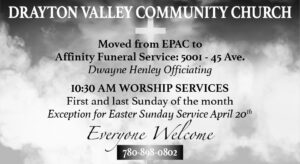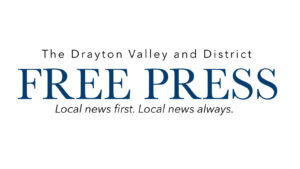Amanda Jeffery, Free Press
Anyone who is 55 years or older will soon be able to access a vehicle to get them to all of their appointments in town, and to some appointments outside of the community.
Drake’s Handi-Bus Services is now being contracted by the Town of Drayton Valley to help those who are older than 55 and those with mobility issues (at any age). Annette Driessen, the General Manager of Community Services for the Town, says they put an RSP out into the community, checking to see if there was anyone who wanted to operate the service, and Drake’s was the one who won.
Dr. Chris Birchall Dentistry
Dr. Birchall Dentistry in Drayton Valley, Alberta. A dentist in Drayton Valley, Alberta.

Church of God
Drayton Valley Church of God. Our Worship Services usually include: traditional hymns, praise choruses, and contemporary songs, prayer, scripture, and a sermon.

Emmaus Lutheran Church
A community of faith passionately walking the road of life with the Lord Jesus. Phone: 780-542-5101, Drayton Valley Alberta

Living Spirit United Church
Everyone welcome. Sunday Worship, 10:30 We are residents of Drayton Valley, members and adherents of

Valley Gallery and Framing
Share on facebook Facebook Share on email Email Share on linkedin LinkedIn Share on whatsapp
“Providing accessible transportation in Drayton Valley has been a priority of Council and I am excited to see this important project come to fruition. Town Council remains committed to offering yearly grants to keep this service operating for the betterment of the community,” says Mayor Michael Doerkson in an email statement.
Amy Newberry, of Drake’s Handi-Bus Services, says the name has historical meaning for the community. “The Drakes were the people of our town that named Drayton Valley because of the Postal Code system, and they were also my great grandparents. It’s a form of leaving a legacy for me,” she said via email.
The scenic route to Lake Louise
“It’s the scenic route to Lake Louise! Start your vacation in Drayton Valley!”
“Wow Graham you are a one man billboard,” I jokingly said to my office colleague.
I won’t tell you what he said back to me.
Scenery and experience were some of the thoughts around the economic development table back when the Sunchild Road was first paved, and although it is still a little known road they were definitely on to something.
The route to the Rockies via Lodgepole/Sunchild Road thru Nordegg is noticeably more scenic, and a nicer drive than any other route to the rockies.
Just 42 km after leaving Drayton Valley you have your first clear view of the Rocky Mountains, and the views just keep getting better from here. The road is hilly with multiple river crossings, with few convenience stores and no restaurants. This route is also a little easier on your pocketbook.
For years Nordegg has been a nice place to pass by on our way to our “actual destination” like Lake Louise, or Banff. But since the Sunchild Road was paved some years back it has become part and parcel of a very scenic road trip to the mountain parks. Nordegg itself has also undergone a bit of a facelift, with a small pump track, a local makers market and coffee shop and a new subdivision.
Drayton Valley through to Nordegg via the Sunchild Road is approximately 178 km and takes two hours non-stop drive time, but we are road tripping it, so it’s nice to allow some time for a stop or two.
To continue on to Lake Louise via the David Thompson Hwy, and then on to Hwy 93 is an additional 171 km, or two hrs and three minutes according to google maps.

Drayton Valley to Hwy 11(David Thompson Hwy)
Kilometre 0 – 50th Street and 50th Ave Drayton Valley
Beginning in Drayton Valley you will take Hwy 620 (Lodgepole Hwy) heading west towards the Brazeau Dam.
Kilometre 32.5 – Lodgepole
Likely your first stop would be Lodgepole. This is a small community with a playground situated right in the heart. If it seems too early to take a break, it is. But, depending on your passenger list I find even a leg stretch this early with kids is beneficial to settling in for a longer ride later in the day.
Located in Lodgepole is a general store, a playground, and I did spy a food truck on the edge of town. If you are truly making a day of it. Then I would also recommend heading north out of town on TWP-753 to get a view of the Pembina River, or to dip a toe or two.
Motorcyclists like to cruise through Lodgepole from TWP-753 on their way to the Brazeau Dam.
Kilometre 42 – a scenic view
Hwy-620 crests at this point and on a clear day the Rocky Mountains can be seen in their majesty.
Kilometre 49 – Elk River Road
Your gateway to the Forestry Trunk Road and the back side of West Country. This is an industrial gravel road and blowing a tire is not an uncommon occurrence so be prepared. Out this way is the Elk River Campground, the Pembina Forks and Fairfax Lake.
Kilometre 54 – a scenic view
Another high point on Hwy-620 with another gorgeous view to the Rockies in the west.
Kilometer 57.4 – Brazeau Reservoir (Dam) and West Canal
During the summer months when the water has thawed and the level rises, the day use area would be a nice place to pull into for a picnic, to go fishing or splash around. The day use beach is mostly rock, but a walk up the beach is possible and along the banks you will happen upon pockets of sand.
If you happen to be in the area in say…early spring, like the kids and I were this April, then the dam is not very interesting and I would encourage you to carry on a half a km to the West Canal road.
Kilometre 57.8 – West Canal Road
The West Canal Road is a gravel road that leads to the West Canal Provincial Campground. Along the road you will also see remnants of crown camping spots: pull outs with makeshift rock fire pits. Not far down the road is a land bridge that connects to an “island” . This is a nice short walk with some expansive views. During the summer this may be a nice picnic spot. During July and August I’ve seen sandpipers running along the beaches of this island.
The West Canal is a fishing destination for some. I have seen some paddlers but there is a noticeable current. This place is not actively swum, however years ago taking scuba lessons I did some of my open water in the West Canal mainly because the current helped with visibility.
Continuing past the Dam you are now officially on the Sunchild Road. The road is named for the O’Chiese and Sunchild First Nations living in the area and as I said it is scenic. With rolling hills, streams, and wild horses, it is a very pleasant drive.
This is not a developed “tourist” route. There are no pullouts, kiosks, hiking trails or pit toilets, when you stop on this road you are here to appreciate the beauty of the surroundings.

Kilometre 73 – O’Chiese Truck stop and O’Chiese First Nations
The O’Chiese truck stop is located on the edge of the O’Chiese first nations reserve. Here, you can get your typical conveniences and fishing supplies and bait.
Kilometre 79 – Nordegg River
Driving along, the Sunchild Road takes a dip into the valley of the Nordegg River. Across the bridge there are rough roads on both sides of the highway that will take you down to the river. The river is fished by anglers, with the most common species include; Northern Pike, Cutthroat Trout and Walleye.
Even if you are not an angler this may be a place to stop on a hot sunny day to stretch your legs.
Kilometre 103 – Sunchild First Nations and gas station
Located along the southern half of the Sunchild Road is Brewster Creek, the Sunchild First Nations and a little convenience store. This store is your last stop to get some refreshments on your way to Nordegg.
Kilometre 109 – Baptiste River
The Baptiste River is a shallow river that can be fished. There aren’t any pullover spots but it is worth a slowdown and a rubber neck.
Kilometre 124 – Hwy 11 junction to Rocky Mountain House or Nordegg
The full stretch of the Sunchild road is mile marked and totals 65 km. With a network of lease roads, and streams with a little curiosity and adventure there are some very rugged spots to be found among the crown land to the west. As for making this route your go on the way to Nordegg. There are a few benefits; it is 20 km shorter, it is scenic, and for now it is quiet, with little chance of getting stuck behind an RV trailer.
Once on Hwy-11 to Nordegg, there are multiple stops, pull outs, fishing haunts and hiking trails.
The Sunchild Road is a more relaxed way to get to mountains. The pace is slower and, using this route your vacation begins as soon as you leave town.

Winter time at Buck Lake
Subscribe for the full Free Press Share on facebook Facebook Share on email Email Share

Try these DV100 training routes
Just beyond the western borders of Drayton Valley is a series of township roads and secondary highways that creates an amazing training ground for anyone looking to tackle the DV100, DV60 or the DV40, this September.
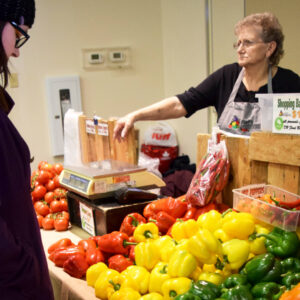
To market, to market: Shopping downtown Drayton Valley
Subscribe for the full Free Press Share on facebook Facebook Share on email Email Share

Tips for beginner mountain bikers
Rocks, berms, extreme pitches, however you slice it, mountain biking is not for the faint of heart. But with a little can-do attitude and grit it can become a fun pastime during any age or stage of life. This summer Rae and Bell decided that they wanted to try something new. Although they were no strangers to road cycling, the purchase of a e-mountain bike got them off the asphalt onto the trail.
Three trips for your winter wonder list
Snowshoeing is a fun way to get outside, stretch your legs and add a little interest to your snowy winter walks. With the Eagle Point Provincial Park and Provincial Recreation area right on our doorstep there are endless places to explore by snowshoe. But for those of you who are just getting started here are three of my favourite places to get you going.

The rugged and refined in Alder Flats
So I have been telling you to explore your backyard and check out places like Evansburg, Breton and Eagle Point Provincial Park. But what about Alder Flats? What the heck is there to do in Alder Flats? To answer this question I have visited Alder Flats five times since July to have a new experience, discover a new place and give you guys some actionable ideas.
Buck Lake
Buck Lake is located 33 min South of Drayton Valley. The closest access to amenities are in the communities of Buck Lake and Alder Flats. It is a large lake that once was used as a commercial fishery and as a means to move logs to the early sawmills.
Buck Lake can be accessed from three different access points:
- From Hwy 22 turn east on to TWP 464 and signs will direct you to the Buck Lake Provincial Recreation Area and campground where you will find a boat launch.
- From Hwy 13 go directly through the community of Buck Lake and off Lakeshore Drive at the community campground you will find an access point.
- From Hwy 13 turn onto TWP 761 and follow the signage to Calhoun Bay Provincial Recreation Area and campground. This is located on the East side of the river.
Buck Lake is a hot spot for winter and summer fishing. Species of fish found in Buck Lake include Walleye, Yellow Perch, Northern Pike, Lake Whitefish.
Please review Alberta Guide to Sportfishing Regulations for more information about fishing in this lake.
Five teams leave league
The Alberta Junior Hockey League is now an 11 team organization. The defection of five breakaway teams to the British Columbia Hockey League was confirmed last week.
“We are disappointed – but not surprised – that the five defecting clubs now intend to drop out of the AJHL to immediately participate in an unsanctioned exhibition series,” the AJHL said in a statement.
The defecting teams are the Brooks Bandits, Okotoks Oilers, Blackfalds Bulldogs, Spruce Grove Saints and Sherwood Park Crusaders. In recent years those organizations have been the most successful in the AJHL. Prior to their defection, four of them occupied the top four places in the league standings for the current 2023-2024 season.
With the five teams now removed from the rankings, the Whitecourt Wolverines jump to top spot on 59 points. The Drayton Valley Thunder sit in tenth place on 34 points. Those two teams met in a rescheduled game on Sunday afternoon, with the Wolverines winning 3-0.
Last week the AJHL thanked the 11 remaining teams for their support as the league looked to move forward. It also indicated that it may be looking at adding more teams before too long.
“The AJHL has a strong future. We are grateful for the messages of support our players and coaches have received from hockey fans across the country over the past week,” the league said. “We also appreciate the expressions of interest coming from various partners and stakeholders who are exploring the possibility of becoming part of our great league.”
It’s still not clear what format the playoffs will take in the downsized AJHL. The regular season continues without the five clubs that are now part of the British Columbia League. That schedule sees the Thunder host the Calgary Canucks on Friday evening before heading to Olds on Sunday to take on the Grizzlys.
Council looks at liquor stores
How many is too many?
Drayton Valley has more liquor and cannabis stores than most similar communities according to a report brought to town council last week. However, council were advised against taking steps to cap the number of such businesses allowed in town.
Dr. Chris Birchall Dentistry
Dr. Birchall Dentistry in Drayton Valley, Alberta. A dentist in Drayton Valley, Alberta.

Church of God
Drayton Valley Church of God. Our Worship Services usually include: traditional hymns, praise choruses, and contemporary songs, prayer, scripture, and a sermon.

Drayton Valley Insurance
Share on facebook Facebook Share on email Email Share on linkedin LinkedIn Share on whatsapp

Emmaus Lutheran Church
A community of faith passionately walking the road of life with the Lord Jesus. Phone: 780-542-5101, Drayton Valley Alberta

St. Anthony Catholic Church
St. Anthony’s Parish Drayton Valley. Weekend mass Saturday and Sunday
Drayton Valley currently has nine liquor stores. That works out to one for every 774 town residents. There are also six cannabis dispensaries, which is one for every 1,162 people.
Those numbers are higher than the equivalent for almost all of the Alberta municipalities surveyed by Town administration. Administration contacted 20 municipalities across the province, ranging in population from 3,461 to 39,348, with particular focus around the 5383 – 9191 population range to serve as a comparison against Drayton Valley, where the population is 6970 according to StatsCan. Of those contacted, 17 municipalities responded to the survey.
An all Canadian team that included a local resident was able to win the rodeo for the first time in the history of the World Famous Miles City Bucking Horse Cowboy Mardi Gras.
Wilfred Titanich was one of a team of three that attended the three-day event in Miles City, Montana from May 15-18. Titanich along with two brothers, Cory and Cody Loken, were the first all Canadian team to win at Bucking Horse since the first Miles City Bucking Horse Sale started in 1951.
Each member of the team came home with around $7,500 US, says Titanich.
“We got Championship Buckles and we got Championship Holders, too,” he says.
The team participated in the Wild Horse Racing event, which involves at least three people and an untouched horse. The horse starts out in the bucking chute and two members of the team follow the horse out, holding onto a long lead. One person is the mugger, and their job is to control the horse’s head by covering its eyes with his arm, which calms it and prevents it from rearing and hurting someone. The shanker holds onto the rope so it doesn’t run away. The rider saddles it, mounts, and holds on tight as they race to the finish line on a wild horse.
“Wild Horse Racing is one of the oldest events in rodeo,” says Titanich.
Though the event is called Wild Horse Racing, the horses used in the event are owned, but untouched.
Throughout the year, Titanich works the Canadian Wild Horse Racing Association Circuit, spending most of his time in Alberta, but also attending some events in B.C. and Saskatchewan, where he competes in both amateur and pro rodeos.
“Honestly, it’s really addicting,” says Titanich. “It looks really crazy, and it is pretty wild, but it’s super addicting. It’s an adrenaline rush in sport.”
He says he would encourage people who like competitive events to try Wild Horse Racing.
The Loken brothers have both been in the sport for about 15 years, says Titanich. Both of them were about 14-years-old when they first started out. Titanich has been in the sport for three or four years.
Normally, the Lokens race with their dad, Jason, and Titanich has his own team. But the three of them thought it would be fun to head down to Miles City for some fun.
The Bucking Horse Sale was a stand-alone event, says Titanich. His team is getting ready for the circuit this summer.
“We can rodeo every weekend from now to the end of October,” he says.
Anyone looking for information about which wild horse racing rodeos are coming up can visit www.wildhorseracing.ca. Titanich says he will be in Brooks at the Lea Park Rodeo this weekend and in Killam for the Killam Rodeo that will be held outdoors in Sedgewick this year.
An author who has written a non-fiction book that ties the Breton area to a mysterious child in Oklahoma will be visiting the Breton Library on June 7.
Russell Cobb, author of Ghosts of Crook County: An Oil Fortune, A Phantom Child, and the Fight for Indigenous Land is a Professor of Modern Languages and Cultural Studies at the University of Alberta. He was invited to the library by the Breton Library Board and the Breton Museum.
Allan Goddard, the manager of the Breton Museum, says he met Cobb when the author was working on the manuscript for the novel.
“He came out to the museum because there is a connection to the Hooks family,” he says.
Goddard says while the book does have some history about the Keystone area, and some relatives that may still live in the area, it is mainly about what indigenous families had to deal with in the early 1900s in Oklahoma.
Claire Sather, the Chair of the Board of Trustees for the Breton Library, says she read the book after finding it on Goodreads, a social media site dedicated to book ratings and reviews.
She says when she got to the end and saw a familiar name, Brandy Fredrickson, it really registered how close some events in the book are tied to the area.
Goddard says when Jim Crow laws came into being in Oklahoma, it triggered an exodus of African Americans from Oklahoma to seek out refuge in Canada. A group of those immigrants settled around Breton in the Keystone area in the early 1900s.
The book centres around a child named Tommy Atkins, whose existence has never truly been proven, and the oilmen who were snatching up indigenous lands in Oklahoma. Goddard says one of the women rumoured to be Atkins’ mother lived in Keystone for a while before returning to Oklahoma.
Both Sather and Goddard are excited to have him visit the Library, however, the space is limited. Those who wish to attend the event on Saturday, June 7th at 1 p.m. have to pre-register to ensure they get a spot.
Those who are interested can register by calling the library at 780-696-3740 or send an email to bretonlibrary@yrl.ab.ca.
Cobb has also written The Great Oklahoma Swindle: Race, Religions, and Lies in America’s Weirdest State.
Eighty years ago this week a group of men gathered in a room in Berlin to sign a piece of paper which brought an end to six years of war in Europe.
It was one of the most significant turning points of the last 1,000 years. It’s an event which will be remembered as well as any in the history of humanity. But history is very much what it is becoming.
World War II will never be forgotten, but it is rapidly becoming little more than a memory.
Anyone involved in the actual fighting would be, at the very least, in their mid-90s. Today the median age in Canada is somewhere around 40. That means the war belongs more to our grandparents’ generation than to our parents’. We’re now approaching the point where no one alive will remember World War II .
Sad as that may seem, it’s part of the inevitable ebb and flow of human events. Things move on. No one today mourns the 65,000 who died at the Battle of Waterloo or those who lost their lives at a thousand other places from Thermopylae to Gettysburg. Instead we are more likely to dress up as them and re enact the events of the day, for reasons that, I must confess, have never been entirely clear to me.
And so it will be with World War II. Certainly the events 25 years earlier at Ypres, the Somme and Passchendaele have now taken on a sepia tinge. They have gone from being a horrendous bloodbath to a historical curiosity.
Time moves on. It’s a natural process and not something we could reverse even if we wanted to.
Years ago I worked with a copy editor who would indignantly write “which one?” in the margins of any news story that simply referred to “the war.” At the time I thought he was a bit of a dickhead. But now, well, I’m still pretty sure he was a dickhead, but he may have been a dickhead with a point.
The world has been far from peaceful since May of 1945. For one thing, the war in Asia was still raging on this day in 1945 and would not end for a few more months with the fall of Japan. But, also this week in 1954 the French were defeated by the Vietnamese in the battle of Dien Bein Phu. This week in 1960 the Soviet Union announced it was holding American U2 pilot Gary Powers. This week in 1999 NATO accidentally bombed the Chinese Embassy in Kosovo. And if you checked the news this morning you probably saw that war continues in Ukraine. Tragedy is continuing to unfold in Gaza. And, well, you get the picture.
Still, by asking “which war” my former colleague may have been a little bit ahead of his time. When someone mentions “The War”most of us will immediately think of 1939-1945.
But time will prove my copy editor’s point. Events, even the most important events in the world, gradually fade into history.
It won’t happen overnight, but make no mistake, it will happen. The process is already under way.
In partnership with the University of Alberta’s Community University Partnership (CUP) town council will be looking at different ways that Drayton Valley residents can work to generate local wealth for the community.
Geraldine Cahill, the director of UpSocial Canada who works with CUP, along with Dr. Maria Mayan from the U of A, spoke to council about initiatives that other municipalities have taken on to help stimulate local economies.
CUP has been working in Drayton Valley since 2020, when they helped the Town develop the Zero Fee Tuition Program, now called the Tuition Assistance Bursary. The partnership was developed for a research project to explore whether the ZFT program could be a mechanism for an inclusive economy.
“The results so far have been very positive, both on employment and also for quality of life for participants,” said Cahill.
Cahill told council they had engaged with stakeholders during the research and found a strategy that they would like to explore with the Town. They believe that Rural Wealth Creation could be an effective initiative to help Drayton Valley navigate increased costs in a way that can benefit the entire community.
“Across the country there has been a pattern of downloading costs and responsibilities to municipalities… without much change in capital transfers,” said Cahill. “That puts a great deal of strain on municipal governments and single-resource towns have been hard hit by this.”
With RWC, the Town would work together with residents to develop ways that residents can invest in community projects as part of their retirement, thus ensuring a larger chunk of local money stays in the municipality.
Over the past few years communities across the country have achieved economic stability by using programs such as co-operatives, local procurement, employee ownership and other succession models, community bonds, community land trusts and more. Cahill also provided examples from some of the municipalities that have gone in this direction.
In 2002, the municipality of Westlock learned that their grain terminals were going to be sold. As agriculture was one of the important sectors for the community, there was concern about how the sale could affect the local economy. So, instead of letting the grain terminals go, the community worked together to raise $1.2 million to purchase the grain terminal.
Those who invested in the terminal now get yearly dividends for their investment. They also have the most profitable terminal for its size in Canada and are planning on diversifying into a transport company.
Cahill says that the size of the municipality may play a role in which type of community program would work best.
Mayor Nancy Dodds asked Cahill how the Town could move forward with the plan as they would have to play a role in whatever path residents choose to move forward with.
“As the Town, as leaders, we want to be involved, but we don’t want to be getting in the way,” said Dodds. “How do you make sure that everyone has their say when you’re picking that.”
CUP has a workshop planned for May 5 at Clean Energy Technology Centre to help brainstorm some ideas that may work in the community. Cahill says everyone is welcome to attend and they will be looking at community assets as well as asking attendees what their priorities are.
Cahill says once they get some feedback from the meeting, she can use those priorities and ideas to generate profiles of which programs could best address them and how it would affect the community.
“Then we can shop them around for several months,” says Cahill. “I don’t want to rush the process so that people have a chance to weigh in.”
In January 1965, the St. Anthony School opened its doors. Now, 60 years later, the school is planning a celebration of the milestone.
Principal Janelle Molzan says they are planning to have a celebration on May 24 at the school gym. They will be using the event to also fundraise for the school.
Molzan says they will have a band performing that evening, catering from a local restaurant, a full cash bar, as well as some door prizes.
Part of the celebration will also be the fact that St. Thomas Aquinas Roman Catholic School Division has put St. Anthony at the top of their priority list for a new school. Molzan says the division has to wait until next year to submit their request to the Province, and there is no guarantee that they will be selected for funding.
“It could be anywhere from two to ten years,” she says. “Or more.”
However, she feels that St. Anthony has a strong case for asking for a new school.
The most recent remodel of the school was in 1992, says Molzan. At that point they expanded the school, removing the gym from the centre of the school and installing classrooms instead. The new gym was then built as an addition to the school.
“We had the addition of the gym as well as a few classrooms in 1992,” says Molzan.
Since then, there have been no major remodels or renovations. Instead, the staff have been doing what they can to keep the building in shape.
“It’s a really well built school,” says Molzan.
She says over the years, the natural heaves and settling that occur with temperature fluctuations has led to some cosmetic damages to the building. “It’s just showing its age,” she says.
While the school is starting to show wear, Molzan says there are no capacity issues. About 15 years ago, the school went from being a K-12 school to a K-8 school when the Holy Trinity Academy was built.
Molzan says if they don’t get a new school they will have to pursue getting more renovations or remodeling for the current building.
Businesses will now have another option for dealing with trespassers thanks to a new program that Enforcement Services have put into place.
Cody Rossing, the manager of enforcement services and emergency management for the Town, says one of the biggest challenges for businesses in the community who were issuing trespass notices is that someone has to attend court in order for the trespassing charge to stick. With the new Trespassing Agent program which comes into place on March 20, businesses who enrol will not have to attend court.
Previously, businesses who contacted the RCMP to report a trespasser had to issue the trespass notices themselves.
For many businesses the process didn’t work well. Larger franchises, like banks, found arranging the issue of a trespass notice and attending court was not logistically feasible. Small business owners, on the other hand, could issue the notice but may have to close their business in order to attend court.
Rossing says there are two different pieces of legislation that speak to trespassing, the Petty Trespass Act and the Trespass to Premises Act.
“Under both of the legislations, the property owner or their agent are required to provide trespass notices, help get people off of their land, and stuff like that,” says Rossing.
The first offence fine under the provincial legislation is normally $600, but it could be up to $10,000. A second offence could have a fine of up to $25,000
The higher fines come into place when the individual ignores the notice and returns to the property. If the trespasser returns three times, the officers can then issue a summons to court. If they fail to attend, a warrant is issued, and at that point if they are found guilty, the higher fines can be given.
Rossing says the program is helping streamline the process for businesses. If they choose to enrol in the program, it will allow peace officers or the RCMP to act as their agent and issue the notices. It also means the business owners won’t have to attend court.
“Court is scary for a lot of people, and we understand that,” says Rossing.
The purpose of the program is to improve the process because officers are continuing to get calls to the same place over and over and business owners or their employees are uncomfortable with the court process. Until now, there hasn’t been any way to address those issues.
“It’s been a lot of work on the back end because there is no follow up process in place and there is no trespass notice being issued,” says Rossing.
He says the hope is that by having this program in place, businesses can sign up and they can begin to address the issue more efficiently.
Several different municipalities in the province have a similar program in place, says Rossing. While developing the program, Rossing did research on other initiatives and reached out to other municipalities that had something similar in place. He says he wanted to be sure that he had everything in place before he announced the program in the community.
There are also checks and balances that have been worked into the program.
“If you’re trespassed from a local business, one of our officers shows up and says you’re trespassed for six months, if you don’t agree with it, you can appeal that process,” says Rossing.
He says there is also the option for the business owners to speak with the officer and reduce the amount of time the individual is trespassed for. In some cases, if the RCMP issue a notice that’s in effect for six months, a business owner may come forward and advocate for the trespasser if the individual doesn’t normally behave in that manner
“They can say, ‘This person is normally a good customer, but there is something going on with him right now. I think maybe a month would be more appropriate,’” says Rossing.
However, it is ultimately the final discretion of the officer.
Once a business is enrolled in the program, they will receive a sticker that they can place in a conspicuous area that is easily visible for officers. If they receive a call, the officer will know that they can issue the notice themselves rather than speaking to the owner and explaining the process that has to take place.
Rossing says enrolment in the program is free, and he encourages businesses to sign up if they are having consistent issues with people loitering or being a nuisance on their property. Those who are interested in enrolling can visit www.draytonvalley.ca/enforcementservices/trespassingagent and fill out the form. They can then email it in to enforcement@draytonvalley.ca or drop it off at the Town office.
The only surveyed municipality with a great concentration of liquor and cannabis stores is Peace River, where the per capita numbers come in at 711 for liquor and 853 for cannabis. The Town of Edson, which is arguably the most similar to Drayton Valley both economically and demographically, has one liquor store for every 1,361 people and one cannabis store for every 2,042.
While Drayton Valley’s numbers appear to be high, the report notes that things could change quickly.
“As the Town currently has single digits worth of licensed stores in both the liquor and cannabis store categories … closure of approximately 2 – 3 stores in each category would be enough to bring the Town more into the middle of all observed municipalities,” it reads. “These amounts of closures are in line with the impacts a typical market correction would have on an over served sector. As a result, administration feels that leaving the success/failures up to the free market, rather than inducing any form of legislative driven impact, would be preferred.”
Jerreck Connors, the Town’s Development Planner said he’d been in touch with the municipality’s lawyers and the advice was that a limit on the number of development permits for a particular use was generally viewed as not legally supportable.
“A true cap is problematic from a legal perspective, and the advice is almost always not to do it,” he said.
The report also noted that Drayton Valley already has planning restrictions in place which effectively limit the number of liquor and cannabis stores due to required setbacks from other institutions in the community. Neither type of store is allowed to open within 150 metres of schools, care facilities, churches or parks. Those regulations are more restrictive than found in most other municipalities.

Canadians lead the way in Montana
Drayton Valley’s Wilfred Titanich helps make Canadian rodeo history at Montana’s Bucking Horse Sale, showcasing Alberta grit and talent.
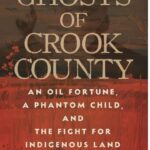
From Oklahoma to Keystone: Uncovering Hidden Histories at the Breton Library
Author Russell Cobb visits Breton Library June 7 to discuss his book linking Oklahoma history to Keystone’s early Black settlers.

VE Day at 80: How World War II Is Fading from Living Memory
Eighty years ago this week a group of men gathered in a room in Berlin to sign a piece of paper which brought an end to six years of war in Europe.

Drayton Valley looks at rural wealth creation
In partnership with the University of Alberta’s Community University Partnership (CUP) town council will be looking at different ways that Drayton Valley residents can work to generate local wealth for the community.
Drayton Valley’s premier theatre troupe, River Valley Players, has survived the pandemic and are now in the audition phase for their first production since Covid arrived in Canada. The group is coming back in full force with their rendition of the southern hit, Steel Magnolias. The play is sure to tug at both the humour and the heartstrings.
Covid has been a widespread problem and local theatre groups that rely on public consumption and funding have been no exception. RVP board member and producer Ashley Luckwell says they have been ready for a while and explains how they managed to stay active.
“We video chatted our meetings, but besides the zombie run last year we haven’t done anything else during the pandemic till now,” says Luckwell. “We are very excited to get back at it! We had planned to put on Steel Magnolias in November of 2020 but then Covid hit so we never even had the chance to hold auditions.”

Valley Gallery and Framing
Share on facebook Facebook Share on email Email Share on linkedin LinkedIn Share on whatsapp

St. Anthony Catholic Church
St. Anthony’s Parish Drayton Valley. Weekend mass Saturday and Sunday
Dr. Chris Birchall Dentistry
Dr. Birchall Dentistry in Drayton Valley, Alberta. A dentist in Drayton Valley, Alberta.

Drayton Valley Alliance Church
Join us Sunday Mornings 10:30 am Everyone Welcome! Phone: 780-542-6501 Email: office@dvalliance.ca Mailing address: Box

Living Spirit United Church
Everyone welcome. Sunday Worship, 10:30 We are residents of Drayton Valley, members and adherents of
Steel Magnolias’ cast is made up of all women actors and is being directed by Melissa Wolf.
“After 25 years improvising and directing at Loose Moose Theatre in Calgary this would be my first chance to direct a scripted show,” she says.
Wolf explains why this piece is important now more than ever.
“Steel Magnolias is a story of life, love and loss and how a community comes together to support each other,” says Wolf.
The theatre group is currently in the audition phase with callbacks being held tomorrow night at the Eleanor Pickup Arts Centre. Luckwell says they are happy with the turnout.
“So far so good. We have quite a few ladies interested,” says Luckwell.
With the closing of all non-essential businesses and venues, holding a production such as Steel Magnolias was an impossibility. However, pandemic certainly wasn’t going to stop the local group from hosting such a powerful and timely play when the time allowed.
“Steel Magnolias is a beautiful play about strong women finding the joy in life,” says Luckwell. “Even in the hardest of times and even if they didn’t always agree, they respected and listened to others opinions.
An all Canadian team that included a local resident was able to win the rodeo for the first time in the history of the World Famous Miles City Bucking Horse Cowboy Mardi Gras.
Wilfred Titanich was one of a team of three that attended the three-day event in Miles City, Montana from May 15-18. Titanich along with two brothers, Cory and Cody Loken, were the first all Canadian team to win at Bucking Horse since the first Miles City Bucking Horse Sale started in 1951.
Each member of the team came home with around $7,500 US, says Titanich.
“We got Championship Buckles and we got Championship Holders, too,” he says.
The team participated in the Wild Horse Racing event, which involves at least three people and an untouched horse. The horse starts out in the bucking chute and two members of the team follow the horse out, holding onto a long lead. One person is the mugger, and their job is to control the horse’s head by covering its eyes with his arm, which calms it and prevents it from rearing and hurting someone. The shanker holds onto the rope so it doesn’t run away. The rider saddles it, mounts, and holds on tight as they race to the finish line on a wild horse.
“Wild Horse Racing is one of the oldest events in rodeo,” says Titanich.
Though the event is called Wild Horse Racing, the horses used in the event are owned, but untouched.
Throughout the year, Titanich works the Canadian Wild Horse Racing Association Circuit, spending most of his time in Alberta, but also attending some events in B.C. and Saskatchewan, where he competes in both amateur and pro rodeos.
“Honestly, it’s really addicting,” says Titanich. “It looks really crazy, and it is pretty wild, but it’s super addicting. It’s an adrenaline rush in sport.”
He says he would encourage people who like competitive events to try Wild Horse Racing.
The Loken brothers have both been in the sport for about 15 years, says Titanich. Both of them were about 14-years-old when they first started out. Titanich has been in the sport for three or four years.
Normally, the Lokens race with their dad, Jason, and Titanich has his own team. But the three of them thought it would be fun to head down to Miles City for some fun.
The Bucking Horse Sale was a stand-alone event, says Titanich. His team is getting ready for the circuit this summer.
“We can rodeo every weekend from now to the end of October,” he says.
Anyone looking for information about which wild horse racing rodeos are coming up can visit www.wildhorseracing.ca. Titanich says he will be in Brooks at the Lea Park Rodeo this weekend and in Killam for the Killam Rodeo that will be held outdoors in Sedgewick this year.
An author who has written a non-fiction book that ties the Breton area to a mysterious child in Oklahoma will be visiting the Breton Library on June 7.
Russell Cobb, author of Ghosts of Crook County: An Oil Fortune, A Phantom Child, and the Fight for Indigenous Land is a Professor of Modern Languages and Cultural Studies at the University of Alberta. He was invited to the library by the Breton Library Board and the Breton Museum.
Allan Goddard, the manager of the Breton Museum, says he met Cobb when the author was working on the manuscript for the novel.
“He came out to the museum because there is a connection to the Hooks family,” he says.
Goddard says while the book does have some history about the Keystone area, and some relatives that may still live in the area, it is mainly about what indigenous families had to deal with in the early 1900s in Oklahoma.
Claire Sather, the Chair of the Board of Trustees for the Breton Library, says she read the book after finding it on Goodreads, a social media site dedicated to book ratings and reviews.
She says when she got to the end and saw a familiar name, Brandy Fredrickson, it really registered how close some events in the book are tied to the area.
Goddard says when Jim Crow laws came into being in Oklahoma, it triggered an exodus of African Americans from Oklahoma to seek out refuge in Canada. A group of those immigrants settled around Breton in the Keystone area in the early 1900s.
The book centres around a child named Tommy Atkins, whose existence has never truly been proven, and the oilmen who were snatching up indigenous lands in Oklahoma. Goddard says one of the women rumoured to be Atkins’ mother lived in Keystone for a while before returning to Oklahoma.
Both Sather and Goddard are excited to have him visit the Library, however, the space is limited. Those who wish to attend the event on Saturday, June 7th at 1 p.m. have to pre-register to ensure they get a spot.
Those who are interested can register by calling the library at 780-696-3740 or send an email to bretonlibrary@yrl.ab.ca.
Cobb has also written The Great Oklahoma Swindle: Race, Religions, and Lies in America’s Weirdest State.
Eighty years ago this week a group of men gathered in a room in Berlin to sign a piece of paper which brought an end to six years of war in Europe.
It was one of the most significant turning points of the last 1,000 years. It’s an event which will be remembered as well as any in the history of humanity. But history is very much what it is becoming.
World War II will never be forgotten, but it is rapidly becoming little more than a memory.
Anyone involved in the actual fighting would be, at the very least, in their mid-90s. Today the median age in Canada is somewhere around 40. That means the war belongs more to our grandparents’ generation than to our parents’. We’re now approaching the point where no one alive will remember World War II .
Sad as that may seem, it’s part of the inevitable ebb and flow of human events. Things move on. No one today mourns the 65,000 who died at the Battle of Waterloo or those who lost their lives at a thousand other places from Thermopylae to Gettysburg. Instead we are more likely to dress up as them and re enact the events of the day, for reasons that, I must confess, have never been entirely clear to me.
And so it will be with World War II. Certainly the events 25 years earlier at Ypres, the Somme and Passchendaele have now taken on a sepia tinge. They have gone from being a horrendous bloodbath to a historical curiosity.
Time moves on. It’s a natural process and not something we could reverse even if we wanted to.
Years ago I worked with a copy editor who would indignantly write “which one?” in the margins of any news story that simply referred to “the war.” At the time I thought he was a bit of a dickhead. But now, well, I’m still pretty sure he was a dickhead, but he may have been a dickhead with a point.
The world has been far from peaceful since May of 1945. For one thing, the war in Asia was still raging on this day in 1945 and would not end for a few more months with the fall of Japan. But, also this week in 1954 the French were defeated by the Vietnamese in the battle of Dien Bein Phu. This week in 1960 the Soviet Union announced it was holding American U2 pilot Gary Powers. This week in 1999 NATO accidentally bombed the Chinese Embassy in Kosovo. And if you checked the news this morning you probably saw that war continues in Ukraine. Tragedy is continuing to unfold in Gaza. And, well, you get the picture.
Still, by asking “which war” my former colleague may have been a little bit ahead of his time. When someone mentions “The War”most of us will immediately think of 1939-1945.
But time will prove my copy editor’s point. Events, even the most important events in the world, gradually fade into history.
It won’t happen overnight, but make no mistake, it will happen. The process is already under way.
In partnership with the University of Alberta’s Community University Partnership (CUP) town council will be looking at different ways that Drayton Valley residents can work to generate local wealth for the community.
Geraldine Cahill, the director of UpSocial Canada who works with CUP, along with Dr. Maria Mayan from the U of A, spoke to council about initiatives that other municipalities have taken on to help stimulate local economies.
CUP has been working in Drayton Valley since 2020, when they helped the Town develop the Zero Fee Tuition Program, now called the Tuition Assistance Bursary. The partnership was developed for a research project to explore whether the ZFT program could be a mechanism for an inclusive economy.
“The results so far have been very positive, both on employment and also for quality of life for participants,” said Cahill.
Cahill told council they had engaged with stakeholders during the research and found a strategy that they would like to explore with the Town. They believe that Rural Wealth Creation could be an effective initiative to help Drayton Valley navigate increased costs in a way that can benefit the entire community.
“Across the country there has been a pattern of downloading costs and responsibilities to municipalities… without much change in capital transfers,” said Cahill. “That puts a great deal of strain on municipal governments and single-resource towns have been hard hit by this.”
With RWC, the Town would work together with residents to develop ways that residents can invest in community projects as part of their retirement, thus ensuring a larger chunk of local money stays in the municipality.
Over the past few years communities across the country have achieved economic stability by using programs such as co-operatives, local procurement, employee ownership and other succession models, community bonds, community land trusts and more. Cahill also provided examples from some of the municipalities that have gone in this direction.
In 2002, the municipality of Westlock learned that their grain terminals were going to be sold. As agriculture was one of the important sectors for the community, there was concern about how the sale could affect the local economy. So, instead of letting the grain terminals go, the community worked together to raise $1.2 million to purchase the grain terminal.
Those who invested in the terminal now get yearly dividends for their investment. They also have the most profitable terminal for its size in Canada and are planning on diversifying into a transport company.
Cahill says that the size of the municipality may play a role in which type of community program would work best.
Mayor Nancy Dodds asked Cahill how the Town could move forward with the plan as they would have to play a role in whatever path residents choose to move forward with.
“As the Town, as leaders, we want to be involved, but we don’t want to be getting in the way,” said Dodds. “How do you make sure that everyone has their say when you’re picking that.”
CUP has a workshop planned for May 5 at Clean Energy Technology Centre to help brainstorm some ideas that may work in the community. Cahill says everyone is welcome to attend and they will be looking at community assets as well as asking attendees what their priorities are.
Cahill says once they get some feedback from the meeting, she can use those priorities and ideas to generate profiles of which programs could best address them and how it would affect the community.
“Then we can shop them around for several months,” says Cahill. “I don’t want to rush the process so that people have a chance to weigh in.”
In January 1965, the St. Anthony School opened its doors. Now, 60 years later, the school is planning a celebration of the milestone.
Principal Janelle Molzan says they are planning to have a celebration on May 24 at the school gym. They will be using the event to also fundraise for the school.
Molzan says they will have a band performing that evening, catering from a local restaurant, a full cash bar, as well as some door prizes.
Part of the celebration will also be the fact that St. Thomas Aquinas Roman Catholic School Division has put St. Anthony at the top of their priority list for a new school. Molzan says the division has to wait until next year to submit their request to the Province, and there is no guarantee that they will be selected for funding.
“It could be anywhere from two to ten years,” she says. “Or more.”
However, she feels that St. Anthony has a strong case for asking for a new school.
The most recent remodel of the school was in 1992, says Molzan. At that point they expanded the school, removing the gym from the centre of the school and installing classrooms instead. The new gym was then built as an addition to the school.
“We had the addition of the gym as well as a few classrooms in 1992,” says Molzan.
Since then, there have been no major remodels or renovations. Instead, the staff have been doing what they can to keep the building in shape.
“It’s a really well built school,” says Molzan.
She says over the years, the natural heaves and settling that occur with temperature fluctuations has led to some cosmetic damages to the building. “It’s just showing its age,” she says.
While the school is starting to show wear, Molzan says there are no capacity issues. About 15 years ago, the school went from being a K-12 school to a K-8 school when the Holy Trinity Academy was built.
Molzan says if they don’t get a new school they will have to pursue getting more renovations or remodeling for the current building.
Businesses will now have another option for dealing with trespassers thanks to a new program that Enforcement Services have put into place.
Cody Rossing, the manager of enforcement services and emergency management for the Town, says one of the biggest challenges for businesses in the community who were issuing trespass notices is that someone has to attend court in order for the trespassing charge to stick. With the new Trespassing Agent program which comes into place on March 20, businesses who enrol will not have to attend court.
Previously, businesses who contacted the RCMP to report a trespasser had to issue the trespass notices themselves.
For many businesses the process didn’t work well. Larger franchises, like banks, found arranging the issue of a trespass notice and attending court was not logistically feasible. Small business owners, on the other hand, could issue the notice but may have to close their business in order to attend court.
Rossing says there are two different pieces of legislation that speak to trespassing, the Petty Trespass Act and the Trespass to Premises Act.
“Under both of the legislations, the property owner or their agent are required to provide trespass notices, help get people off of their land, and stuff like that,” says Rossing.
The first offence fine under the provincial legislation is normally $600, but it could be up to $10,000. A second offence could have a fine of up to $25,000
The higher fines come into place when the individual ignores the notice and returns to the property. If the trespasser returns three times, the officers can then issue a summons to court. If they fail to attend, a warrant is issued, and at that point if they are found guilty, the higher fines can be given.
Rossing says the program is helping streamline the process for businesses. If they choose to enrol in the program, it will allow peace officers or the RCMP to act as their agent and issue the notices. It also means the business owners won’t have to attend court.
“Court is scary for a lot of people, and we understand that,” says Rossing.
The purpose of the program is to improve the process because officers are continuing to get calls to the same place over and over and business owners or their employees are uncomfortable with the court process. Until now, there hasn’t been any way to address those issues.
“It’s been a lot of work on the back end because there is no follow up process in place and there is no trespass notice being issued,” says Rossing.
He says the hope is that by having this program in place, businesses can sign up and they can begin to address the issue more efficiently.
Several different municipalities in the province have a similar program in place, says Rossing. While developing the program, Rossing did research on other initiatives and reached out to other municipalities that had something similar in place. He says he wanted to be sure that he had everything in place before he announced the program in the community.
There are also checks and balances that have been worked into the program.
“If you’re trespassed from a local business, one of our officers shows up and says you’re trespassed for six months, if you don’t agree with it, you can appeal that process,” says Rossing.
He says there is also the option for the business owners to speak with the officer and reduce the amount of time the individual is trespassed for. In some cases, if the RCMP issue a notice that’s in effect for six months, a business owner may come forward and advocate for the trespasser if the individual doesn’t normally behave in that manner
“They can say, ‘This person is normally a good customer, but there is something going on with him right now. I think maybe a month would be more appropriate,’” says Rossing.
However, it is ultimately the final discretion of the officer.
Once a business is enrolled in the program, they will receive a sticker that they can place in a conspicuous area that is easily visible for officers. If they receive a call, the officer will know that they can issue the notice themselves rather than speaking to the owner and explaining the process that has to take place.
Rossing says enrolment in the program is free, and he encourages businesses to sign up if they are having consistent issues with people loitering or being a nuisance on their property. Those who are interested in enrolling can visit www.draytonvalley.ca/enforcementservices/trespassingagent and fill out the form. They can then email it in to enforcement@draytonvalley.ca or drop it off at the Town office.
Any group taking more than two years off is bound to collect some dust and Luckwell jokes about why they stuck with Steel Magnolias.
“We like that the cast is smaller so it’s a great way to start getting our toes wet again.”
The River Valley Players has been active for more than 10 years and with theatres and halls now fully open, they plan to get back to business as usual.
“We had our Acting Out reunion on June 4 and then the Zombie Run is back again this fall,” says Luckwell. “As well as we plan on the return of our Acting Out classes for the youth.”
While enjoying fun and games at the recently celebrated reunion, current students and alumni reminisced about productions past and discussed any pieces the troupe could tackle in the future. Focusing on education and socialization, the Acting Out youth classes are an important part of the River Valley Players. The group hosts classes in a multitude of Theatre Arts and Stage Production. Groups of youth from grades 4-8 and 9-12 can have fun while learning about acting, sound, stage management, lighting, makeup, improvising and more.
Largely thanks to it being an outdoors event, the only production RVP was able to do last year was their ninth annual Zombie Run. The scary adventure combines the benefits of healthy physical activities with Hollywood like zombie effects and full makeup. Children and adults are chased through the woods of Willey West campground by volunteer zombies. They are all horror fans that have gone through what the group calls Zombie Boot Camp. During the short course, they learn makeup and movement techniques to make the spooky experience more authentic for the audience. The annual October event has boasted over a thousand attendees in years past and the group is looking forward to bringing it back in full swing for its tenth year.
The River Valley Players certainly don’t want to be thought of as lazy. Along with their many productions, they are already looking to next year.
“We hope to hold our one acts next year and find the musical to put on next year, as well as the Zombie Run and 24 hour musicals,” says Luckwell.
The annual One Act Festival is another exclusive event produced by River Valley Players. The theatre production is a display of talent both young and old. Consisting of only one act plays, the event goes all day with youth plays being presented in the afternoon and adult plays running in the evening.
Now that auditions for Steel Magnolias are over, the casting process will begin with rehearsals to follow. Watch for the Southern belle play to premiere on Drayton Valley’s stages after the summer. Show dates are October 28, 29 and November 4, 5.
River Valley Players has managed to do what a lot of other groups haven’t over the course of the pandemic, hold on to their membership. They were able to maintain 11 full-time members including two youth members. With lots of shows on the horizon, Luckwell says there is always room for more members.
“We are always looking for volunteers. We would love for our theatre family to continue growing bigger and bigger,” she said.

Canadians lead the way in Montana
Drayton Valley’s Wilfred Titanich helps make Canadian rodeo history at Montana’s Bucking Horse Sale, showcasing Alberta grit and talent.

From Oklahoma to Keystone: Uncovering Hidden Histories at the Breton Library
Author Russell Cobb visits Breton Library June 7 to discuss his book linking Oklahoma history to Keystone’s early Black settlers.

VE Day at 80: How World War II Is Fading from Living Memory
Eighty years ago this week a group of men gathered in a room in Berlin to sign a piece of paper which brought an end to six years of war in Europe.

Drayton Valley looks at rural wealth creation
In partnership with the University of Alberta’s Community University Partnership (CUP) town council will be looking at different ways that Drayton Valley residents can work to generate local wealth for the community.
The great thing about golf is that you always get a second chance. Even if you’ve just shanked your ball into the trees, there’s always another shot to make. Quadruple bogey? Meh. You can shrug it off and try again at the next hole.
But for all that, after some of our efforts last year, our trip to the Drayton Valley course is best summed up as a triumph of hope over experience.
But there was lots to like. The course itself is in very good shape, in spite of our efforts to dig parts of it up with an over enthusiastic pitching wedge. And it was great to get out in some early morning sunshine.
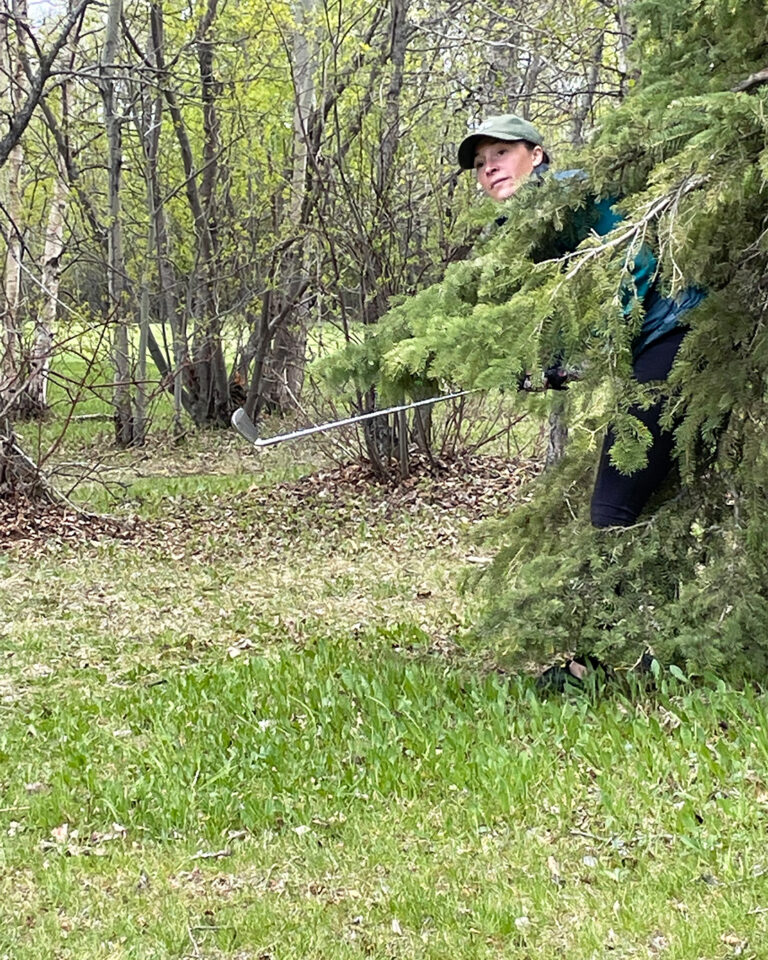
We teed off well ahead of anyone else and the course was ours. My eyes settled on the long stretches of vibrant green fairways, manicured tees and greens, I could hear geese and ducks as we motored by ponds between the holes. There was a wind to be sure but the sun was shining and the day promised to be a good one.
This was the first game of the year for both of us. Taking several months off hasn’t done much to improve our shot making. But golf is about fun. And we had plenty of that.
Every hole up to hole seven had some redeeming qualities – a good putt here or a nice drive there – but no hole was an out and out triumph. Then we approach hole seven, a par three that is just long enough to cause both of us to pause and give careful consideration to our clubs of choice.
I chose too much club and managed to whack the ball out of bounds into a nearby resident’s septic field and spent the next three hits seeking my way back to the green.
My partner, Graham Long, did the opposite and wound up in a greenside bunker. An over cooked sand wedge overshot and missed the green completely. But, in an act of total redemption he managed to make a 20 yard chip roll right into the hole.
“The ugliest par you ever did see,” he said.

Playing a serious 18-hole golf course can be intimidating for the average golfer. But similar to the way using the best knives somehow makes cooking more enjoyable, golfing on an immaculate golf course is a much better experience than wrestling with patchy greens or uncut tee boxes. The greens at Drayton Valley’s course are smooth, fairways are well taken care of, and the fringe transitions allow for course correction without having to bring out the weed whipper. The landscape of the course contributes as much to the experience as a good hole or a good shot.
I had been shooting really well for a couple of holes, with long straight drives, and good iron work. Then we got to hole 12. A good drive was followed by some solid iron hits, and I was in front of the green.
Par or at least a single, (ok double) bogey seemed within reach. Then a shanked chip put me into the sand trap to the left of the green. My aspirations were sand bagged. I really hate the sand. Consistency does not live in the bunker. Hit the ball too soft and you go nowhere, hit it too hard and well…
I lined up, marked the sand where I wanted the club to grab and swung. Whack!
Oh boy. The ball didn’t just pop up onto the green like I planned. No siree. It shot off like a rocket way up over the trees.
“Did you see where my ball went?” I asked Graham.
“Lodgepole,” he said.
The thing about these rural courses is that they are often similar calibre to what you find in the city but they are half the price, and way easier to get a tee time.
Brandy Fredrickson
But as I said, there’s always another hole and there’s always that chance for redemption. And if it doesn’t come, then there’s always another day.
And at the end of it all, we had a great time. The people were friendly. The booking process is easy. And, at the risk of sounding repetitive, the course is in as good a shape as either of us have ever seen it. The thing about these rural courses is that they are often similar calibre to what you find in the city but they are half the price, and way easier to get a tee time.
So what was the final score? There are some things a lady does not divulge, although it’s fair to say it was more than we hoped it would be.
But it’s not all about how you play; it’s about how you feel. And after a few hours of fresh air and some not too vigorous exercise, we both felt pretty good.

Winter time at Buck Lake
Subscribe for the full Free Press Share on facebook Facebook Share on email Email Share

Try these DV100 training routes
Just beyond the western borders of Drayton Valley is a series of township roads and secondary highways that creates an amazing training ground for anyone looking to tackle the DV100, DV60 or the DV40, this September.

To market, to market: Shopping downtown Drayton Valley
Subscribe for the full Free Press Share on facebook Facebook Share on email Email Share

Tips for beginner mountain bikers
Rocks, berms, extreme pitches, however you slice it, mountain biking is not for the faint of heart. But with a little can-do attitude and grit it can become a fun pastime during any age or stage of life. This summer Rae and Bell decided that they wanted to try something new. Although they were no strangers to road cycling, the purchase of a e-mountain bike got them off the asphalt onto the trail.
Three trips for your winter wonder list
Snowshoeing is a fun way to get outside, stretch your legs and add a little interest to your snowy winter walks. With the Eagle Point Provincial Park and Provincial Recreation area right on our doorstep there are endless places to explore by snowshoe. But for those of you who are just getting started here are three of my favourite places to get you going.

The rugged and refined in Alder Flats
So I have been telling you to explore your backyard and check out places like Evansburg, Breton and Eagle Point Provincial Park. But what about Alder Flats? What the heck is there to do in Alder Flats? To answer this question I have visited Alder Flats five times since July to have a new experience, discover a new place and give you guys some actionable ideas.
She also feels strongly about the seniors in the community, who have contributed so much of their efforts to make Drayton Valley the town that it currently is.
“I felt that it was past due for our town to give back to our seniors and help them out as much as possible. Without them we wouldn’t have had a town to call home.”
Driessen says the project has taken a while to put together. “It’s been in the works for quite a few years and we have to thank [many] for their contributions. It’s been a community collaboration without a doubt.”
Newberry says she is also grateful for the generosity and hard work of community members, including one local hockey team, that were able to ensure the project was a success.
Driessen says this service isn’t just for medical appointments. She says in some cases that means getting groceries, going to the pharmacy, or sometimes, the polls for an election.
“We will be providing a special in town service every Wednesday, so that our seniors can go shopping and get their groceries or medications along with their senior discounts,” says Newberry.
There will be a fee for the service, says Driessen. The Town researched and found a reasonable cost comparison with cab services in the community. Driessen says it will be comparable to cab services. “It does, of course, give a bit of a break,” she says.
In the future, Driessen says they would like to see some public funding allotted to the service to help lower the cost for those who need it.
Newberry says that paying for the service is set up with a digital payment service, allowing family members to easily help out their loved ones.
“It will work on digital payment service program where a family member or the person (senior or disabled) can purchase a prepaid visa gift card. Every time a person needs a ride the card will be debited the amount of the ride. Until the card is used up. Then it’s a matter of reloading it with money at that time. Could be a great Christmas gift from family to a loved one,” she says.
Those who are interested in registering their family for the service can contact Drake’s Handi Bus at 780-542-8706.







